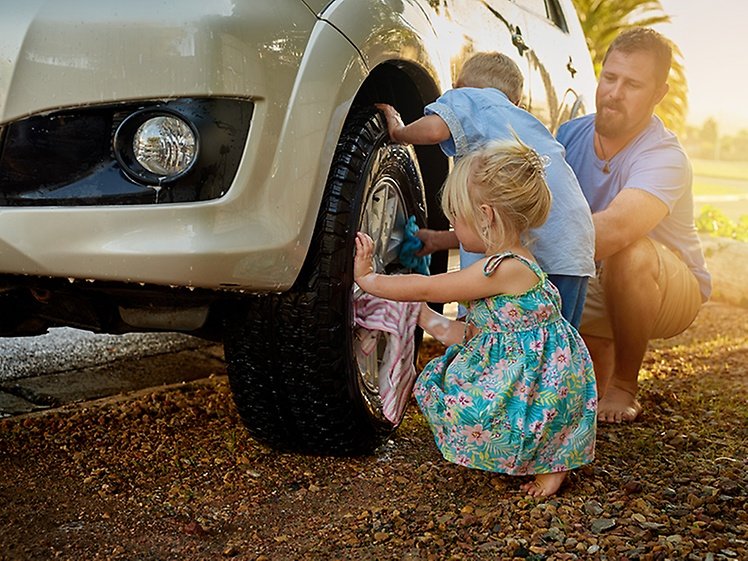Tyre care: How to keep using your tyres for as long as possible
Did you know that only an area of your tyres the size of a postcard comes into contact with the road? Every square centimetre of this contact surface helps to ensure that you can enjoy complete driving safety in wind and rain. That is why we recommend that you care for your car tyres on a regular basis. This can be done when you clean your rims, however, it involves regularly checking the tyre pressure, tread depth and the tyre conditions. We explain how often you should do certain things to ensure that you can use your tyres for as long as possible.
Our recommendations for your car tyre care
You should carry out certain checks so that you can use your tyres for as long as possible. Some of them have recommended intervals, for example because tyre pressure can decrease over time. Other checks are only needed where appropriate, for instance after an unwanted collision with the curb.
Regular
- Measurement of the tyre pressure every 14 days.
- Checking of the tread depth every 14 days, ideally before every long journey.
- Visual check for damage caused by sharp objects, cuts, cracks and bumps.
Seasonal
- Balancing the seasonal tyre change.
- Keeping track of the tyre age.
- Inspection of the valves and valve caps.
- Tyre cleaning and care.
As required
- Visual check for cracks, scratches and/or bumps after bumping the curb.
- Check for irregular wear and tracking after hitting a pothole.
Tips
You don't need to note the exact age of your tyres. The reason being: You can use the DOT number (four-digit code) on the tyre to determine the tyre age, as well as the speed class. We explain how important the age and tread depth of your tyres are.
Damaged rims are potential road traffic hazards. This damage can lead to hairline cracks which increase in size over time. Although rims can be repaired as necessary, it is only legally admissible to use rims with damage that is no deeper than 1 mm.
Part of car tyre care: Cleaning
Tyres and rims that are well cared for not only look better, they also last longer. This prevents your tyres from wearing out quickly. When you care for the rubber and clean the rims is up to you. However, you should care for your tyres before storing them at the very latest. Convenient: If the tyres are not mounted on your car, they are easier to clean and you protect the paint finish from dirt and small stones.
Do not use any heavy-duty cleaning agents that contain solvents or oils for rough cleaning. These are not suitable for tyres and most rim types. Instead, use lukewarm water, a sponge, a brush and some washing-up liquid or an all-purpose cleaner. You can also use a high-pressure cleaner, if you have one. This works particularly well for cleaning steel and alloy rims. However, it is important that you switch to a nozzle with a wide jet because circular jet nozzles wear away the material of your tyre. If you do not have a high-pressure cleaner, you can use a special rim cleaning programme at a car wash.
Depending on the type of rims you have, proceed as follows:
For light alloy rims, it is best to clean them with a rim cleaner that is tailored to the material. Apply the cleaner with a cotton cloth, a soft brush or a sponge, depending on the consistency of the cleaner.
Use a rim cleaner to clean steel rims. The difference to alloy rim cleaner: It should be left to work for a certain amount of time that is specified in the instructions. Afterwards, you can usually continue with a brush or cloth.
Cleaning lacquered rims requires a little more caution. Please refer to the cleaner instructions to check whether it is suitable for lacquered rims.
When cleaning rims, don't forget to clean the rear side. Dust from your brakes can eat into the material and damage it.
The final step when caring for tyres and rims: The polish
If you are storing tyres for a season, it is worth polishing the rims. If you have been to the car wash for a clean, you can take action against the blotchy residue on your tyres. You can remove it with a special tyre cleaning agent from the tyre dealer or at the car accessory shop. Please make sure that this is only applied to the edges as the cleaning agent makes the running surface slippery.
Use a rim sealant when polishing your alloy rims. Another advantage: You can also remove small scratches from the rims. To do this, apply some pressure to the scratch while polishing and sealing your alloy rims. The rim sealant is also suitable for caring for steel rims. This is highly recommended if you want to store your tyres with the rims.
By following these tyre care tips, you will be able to enjoy your tyres for a long time.
Source: Uniroyal







